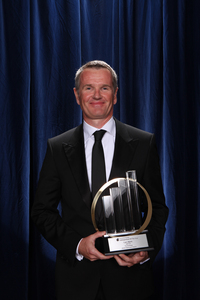Over the past few years, there has been an explosion of applications, particularly in mobile. Everything from instant stock quotes, to weather forecasts and GPS navigation are now available with a touch of your finger on your cell phone. Surgeons can scroll through years of patient history in minutes. Smart meters bring instant feedback to consumers, reducing energy waste and saving money, without any sacrifice to lifestyle.
Ever wonder which companies aggregate all of that big data into compelling and easy-to-use visuals? It turns out that there are three entrepreneurial companies that are leading innovation in the industry -- Qlik Technologies, Inc., Tableau Software and Tibco (source: Gartner).
I had the opportunity to speak with Lars Bjork, the CEO of Qlik Technologies, on May 16, 2014, to learn more about business intelligence technology, and his plans for continuing to innovate faster than Oracle, IBM and SAP.
Natalie Pace: Qlik has some pretty impressive clients. Can you give us an example of a company that uses your dashboard to increase their profit margins, or improve their sales and reach?
Lars Bjork: We have 32,000 customers. We're in many different verticals. Take King.com. This is the company behind the game that everyone is playing -- Candy Crush Saga. They use QlikView to read about two billion rows of data from 190 million players every day. For them, it is very important to understand: What part of the game is being played? How long do you play it? What's the next outcome that the players will do? They have to continue to invent in their industry.
NP: The clean technology industry is using Qlik Technology, as well. What role do you play there?
LB: [Utilities] collect lots of data from smart meters. That helps them to understand efficiency. More importantly, they can report back to the Department of Energy, who funds many of their programs -- all in an effort of how we can be smarter in usage of power, and lower our consumption.
NP: I saw a shocking Qlik dashboard concerning the California drought crisis. It's easy to see the power and impact of visuals in, hopefully, motivating people to conserve water and change their habits.
LB: We are very focused on corporate social responsibility. One of the organizations that we have helped is Circle of Blue, which is an international network of experts who are dedicated to one of the big challenges in the world, and that is clean water. They built a dashboard on our tool to analyze water reservoir levels in California, as part of the White House Climate Data Initiative.
These are three very different examples. The common denominator is that from data you can draw insightful information and make use of and make decisions from it, or report back to somebody who can make valuable decisions from it.
NP: Lush Cosmetics reported savings of $1 million in the first two years of their deployment of your technology. How did your business intelligence solution translate into savings for that company?
LB: For Lush Cosmetics, we drive in-store profitability by optimizing stock levels - by not being out of stock or being overstocked. It's all about understanding the pattern of the customers' behavior when it comes to purchasing their merchandise, and being on top of that. We've done that for a number of retail clients, where margins are very, very small. You can draw a lot of benefits -- besides not locking up as much money in stock.
NP: One of my favorite testimonials comes from Dr. Klaus Hamm, who writes that as a result of your data and earlier detection of breast cancer, they have reduced mastectomies to 12 percent and are able to use gentler treatments. How does that work?
LB: The health care industry is not the most tech savvy industry, and they need to catch up. By digitizing records, and by pulling records in from many, many years of experience, you suddenly have a complete view in front of a surgeon, who can make a smarter decision. They have been able to lower breast cancer by having a comprehensive picture. We've seen this at the Children's Hospital and in other treatments, too. The interesting thing here is that while revenue and profits are the drivers for corporations, I am equally intrigued by saving lives or finding treatments to illness early in the process, and therefore saving that patient's journey through a painful surgery.
NP: There are other companies in the medical technology space, like Cerner and Athena Health. Are you providing the same kind of solution? Do you have a market edge?
LB: I see Cerner and others in this space primarily as partners. They provide the legacy transactional system to capture the data. What they then need is a tool or a platform where you can present this back in a very intuitive way - a dashboard. We sit on top of their solutions, or partner with their solutions.
NP: Qlik seems to have personalized many very different applications to a broad range of customers and industries. How are you able to do that efficiently and profitably?
LB: We have taken a very different approach to this market by focusing on the user experience. We make it possible for anyone to build applications and make changes to applications. Therefore, the market opportunity is almost infinite. The experience we have through an iPhone or another smart phone, or an iPad or other tablet, has suddenly empowered the individual, giving them an experience that they now bring to their work life. We're driving that in our industry - [where] the user intuitively understands the [app] in seconds. They don't even reflect that it is a piece of software. They just open it and do what they are supposed to do. With the more traditional experience in enterprise software, it is heavy. It is service intense. You feel dumb because you don't fully understand the system. And you certainly cannot make any changes to it. So, that's what we have disrupted in this industry, and we can continue to disrupt for a long, long time. We know that the vast majority of the potential user base doesn't have access to tools like this.
NP: You have a new product coming out in a few months. What is different about your QlikView.Next?
LB: QlikView.Next will have a free personal download. This is a way for anyone to try it before you buy it, experience the power of the tool and to share it amongst a work group in the cloud. It comes out in the beginning of the third quarter.
In addition to downloading the product, we also encourage users to join our Qlik Community. It's one of the biggest, if not the biggest, in our industry with over 100,000 people actively sharing best experiences and talking to each other. It's a great way to be encouraged about the fact that you yourself were able to build an application, with very limited help.
NP: 2013 was a cash negative year for Qlik Technologies. Will the company be profitable in 2014?
LB: Yes. The focus is on growing the business first and foremost, while still delivering a respectable profit, but not to try to maximize profit yet. We're trying to maximize the opportunity to grow. Most of this market opportunity is undone. So, it would be unwise to start focusing on optimizing and maximizing profit at this point.


